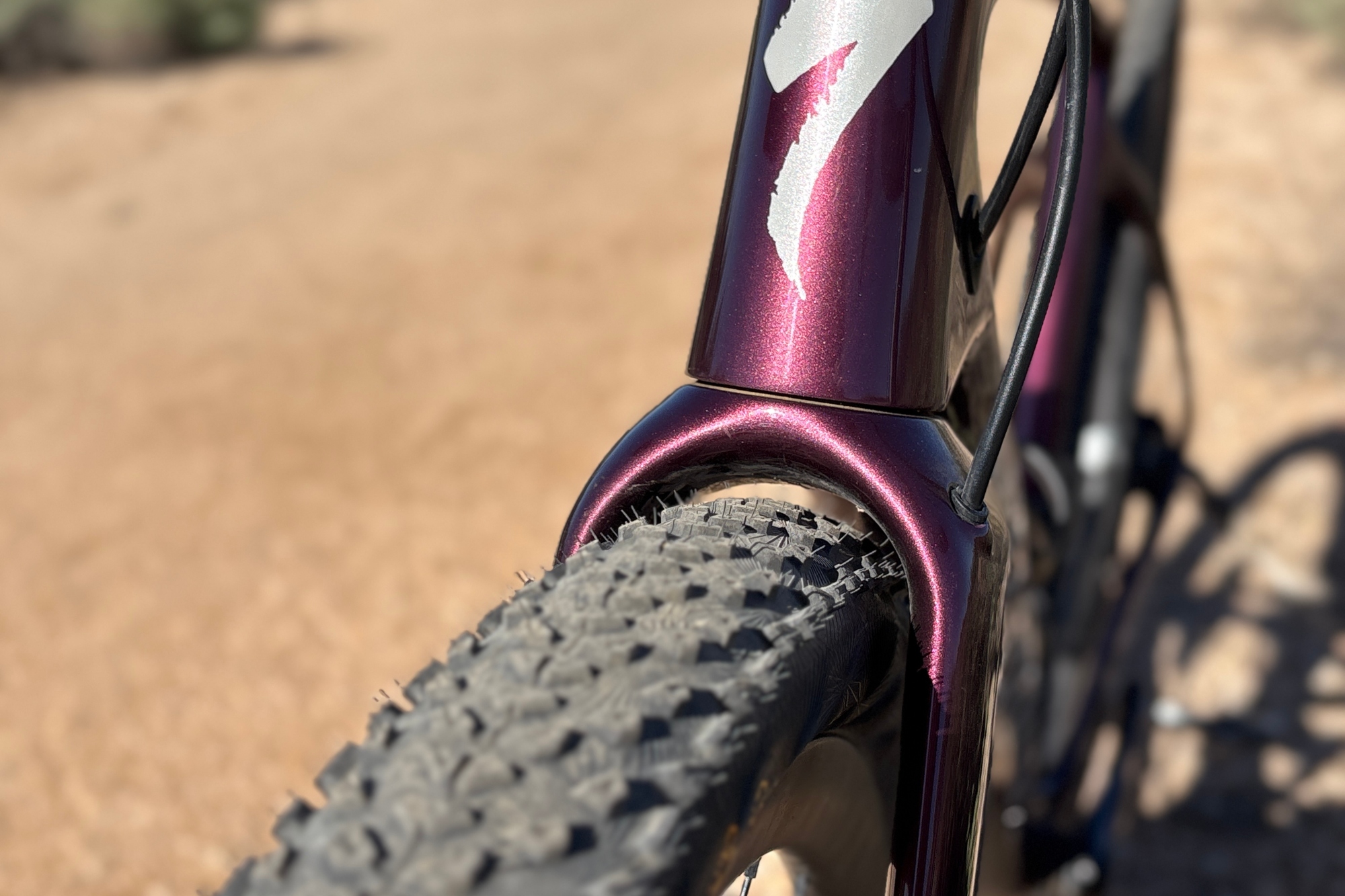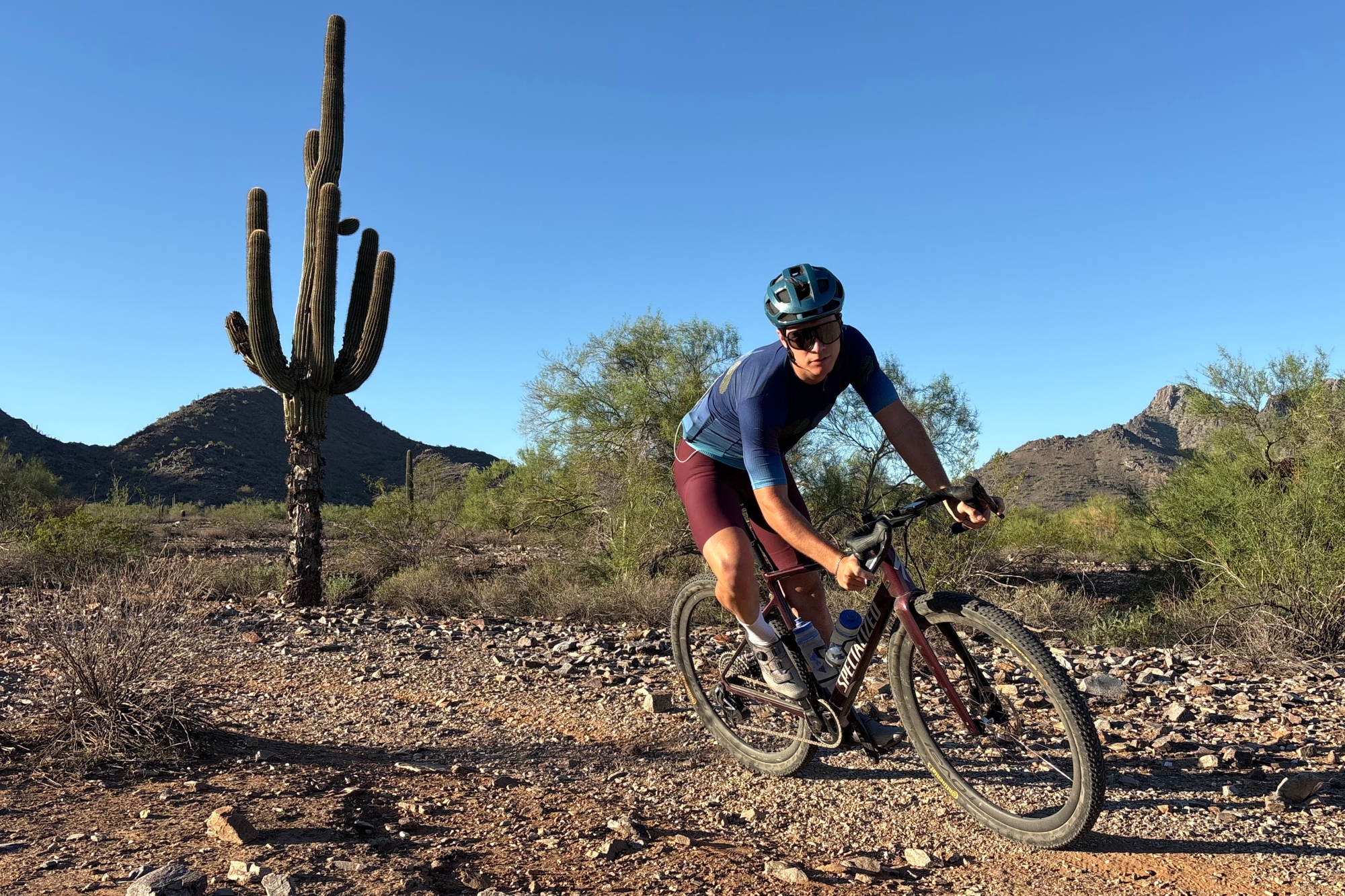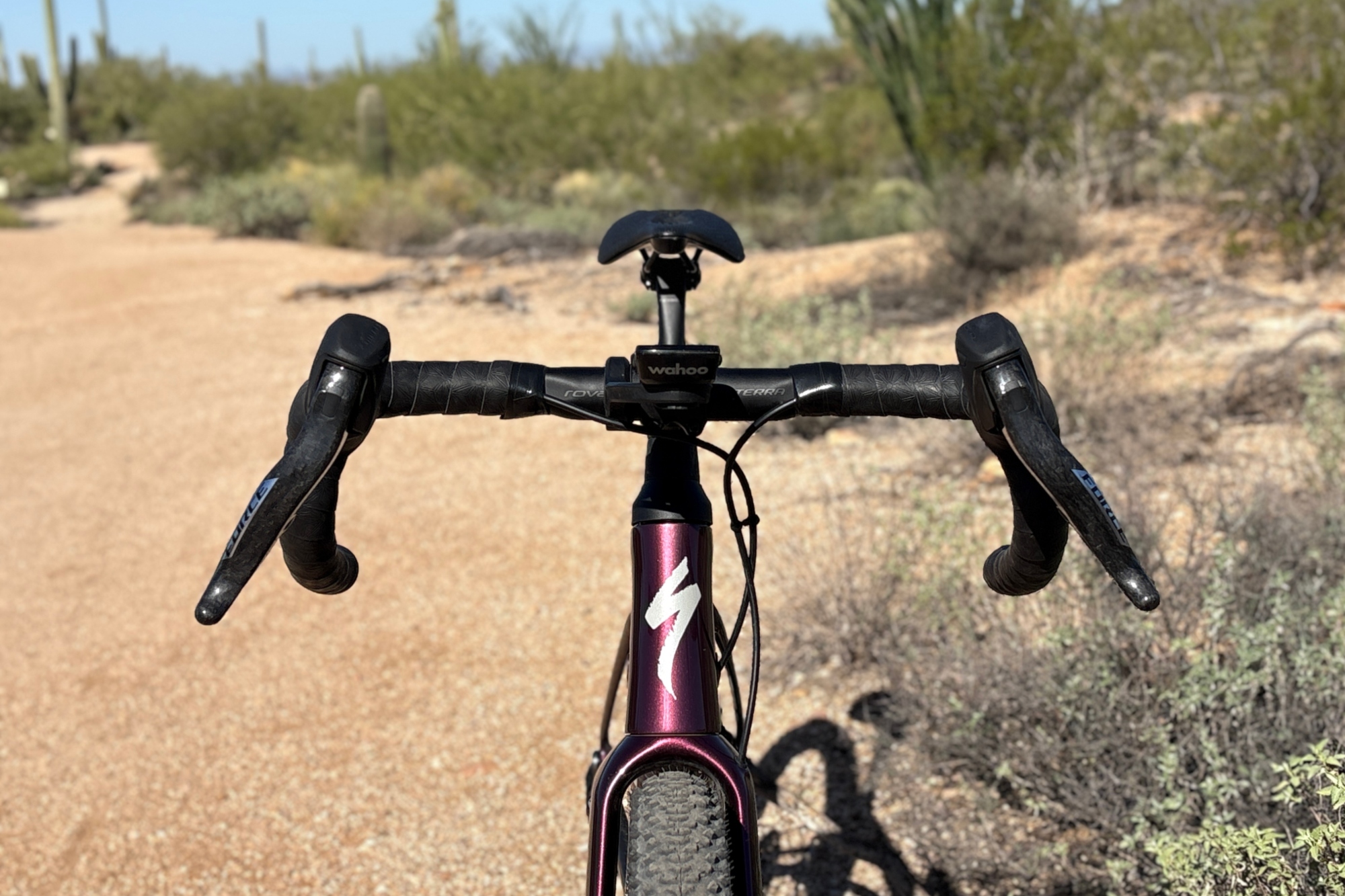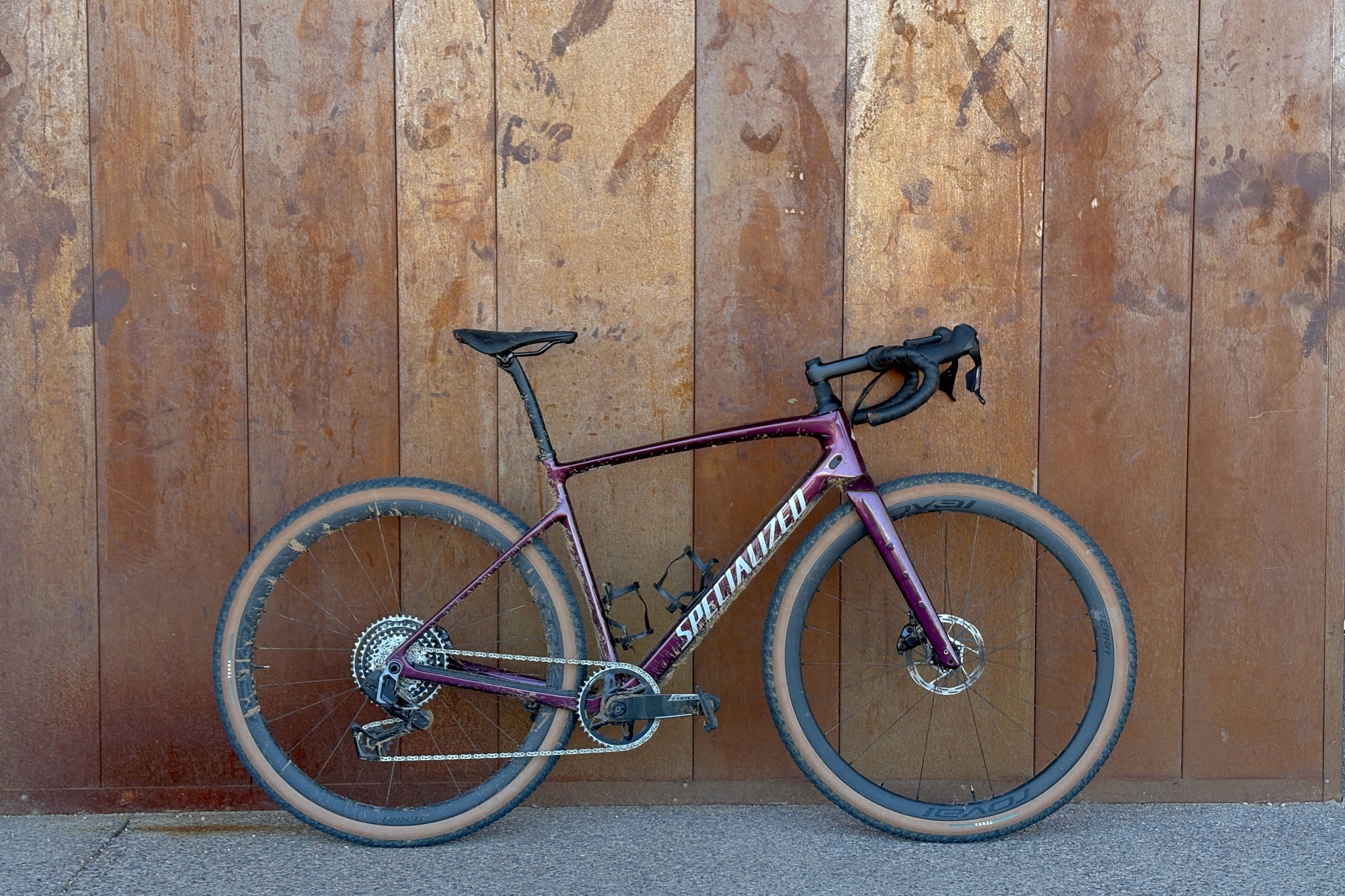Specialized has updated its Diverge gravel bike, moving away from its STR rear suspension system and toward a more neutral but compliant frame design.
First seen at Unbound Gravel in May, the bike retains its Future Shock 3.0, with 20 mm of travel stored in the steerer tube, while the seat post is designed to deflect backward over the roughest terrain. This post creates a balanced bump dampening without adding the weight and moving parts of the Future Shock Rear suspension system as seen in the STR models.
“We engineered this bike with input from racers, adventure riders, and scientists. It’s the most versatile Diverge ever,” says Luke Callahan, Specialized’s lead engineer for the new bike.
Of course, that statement isn’t anything new. Specialized has always positioned the Diverge as the do-it-all machine. However, by shedding weight, retaining rear compliance, and boosting the tyre clearance by three millimetres in the front and rear, the new Diverge certainly seems like it is keeping pace with the other options from the big brands.
Tweaking compliance
(Image credit: Logan Jones-Wilkins)
The Diverge 4 seems to be two steps forward and one step back when it comes to the balancing act of addressing the need for compliance while keeping the weight down and the handling responsive.
The step back, in my opinion, is losing the Future Shock Rear. It was by far the most hyped design element of the previous iteration of the Diverge, but also its most controversial. Rear suspension is gone entirely, with the seat stay, seat tube, and top tube coming together in a way that looks in line with the brand’s tendency to build around slightly dropped seat stays and a traditional seat clamp.
The first step forward, as a way to address rear-end compliance, is the addition of the Roval Terra seat post. The offering from Specialized’s sub-brand is a compliant seat-post that provides a small, but significant, 18mm of rear deflection. Pair that post with the front Future Shock, and the bike offers 20mm of “suspension” to smooth out most bumps and imperfections found on most gravel roads.
The second step forward is the significant increase in tyre clearance. The posted clearance for the bike is 50mm in the front and the rear, however, Specialized suggests that a 2.2 tyre could fit in the frame just fine. We will get into the downstream effects of this clearance in the next section, but the increase in clearance is a welcome addition to a bike that prides itself on versatility.
Building geometry around the modern trends

Massive tyre clearance on the Diverge 4: 2.2-inch MTB tyres fit just fine
(Image credit: Logan Jones-Wilkins)
The Diverge 4 takes an off-road-riding first approach with a geometry that design around big tyres, comfort and stable handling over rough terrain.
Most notably, the front end is slacker and the reach is longer than its predecessors, gearing the steering more towards the mountain bike side of things. This encourages riders to run shorter stems to balance out a shallower head tube angle that provides that smooth, stable platform.
At the rear, Specialized has lengthened the chainstay to improve clearance and balance weight distribution. In gravel bike design, chainstay length is a major point of division: brands like Ventum and Pivot prioritise keeping the chainstay as short as possible, even with slack geometry, while others, like Allied, take a more flexible approach. With a 430 mm chainstay, the Specialized Diverge falls into the latter camp.
From my initial rides with 45mm tyres, the bike doesn’t feel unwieldy by any means. The balanced feeling of the height is quite nice to have on the road, especially when you want a predictable feeling, even if the steering is generally slower.
Lastly, the Diverge has lowered its bottom bracket. On some bikes, this can be a big adjustment, but with the bike built around bigger tyres, this move to lower the bottom bracket is more of a corrective move toward keeping the same stand over height than any progressive change in frame geography.
Ride feel

(Image credit: Logan Jones-Wilkins)
Right off the bat, the bike’s length, both in reach and wheelbase, stands out as the main takeaway. With the Future Shock suspension raising the bars higher than usual, that extra length is a welcome balance. The higher, longer position feels powerful and racey enough for the gravel riding I do. It wasn’t close to my road position, but that’s not necessarily a bad thing. This bike isn’t meant to be a do-it-all machine: it’s a gravel bike designed very specifically for gravel roads, trails and tracks.
Gravel is an interesting discipline in cycling because end-use design can make or break how a bike fits a rider’s needs. Many riders want their gravel bike to be a “quiver killer,” one that can handle a bit of everything. The Diverge isn’t that. It’s not a gravel bike for the gravel generalist who sees gravel as a blend of road, dirt and everything in between. That’s the Crux’s territory. The Diverge trades that versatility for something more focused; a design tuned specifically for off-road performance.
And in that focus, it truly excels. It’s hard to find fault with how the geometry translates once you get it on dirt.
Over the month I spent riding it, I tried to cover as much of the Sonoran Desert’s terrain as possible: road group rides, smooth gravel stretches, sandy and beaten-up jeep roads, rocky two-track and slick, twisting singletrack. On one ride, I even threw in an enduro mountain bike trail just to see how far the long wheelbase and stable frame could be pushed.
Through all that experimenting, one feeling kept surfacing: joy. The Diverge gave me a strong sense of security on everything I threw at it. That confidence quickly turned into speed as I learned how well the bike held traction, smoothed bumps, and handled drops and rocks that would trip up a tighter, snappier gravel bike. With its long wheelbase, low bottom bracket and generous clearance, it felt like a freight train on wheels, ploughing through fast corners on the loosest gravel you could imagine.
Where it did falter was at slower speeds. In tighter turns or technical bits where precision matters, getting the front wheel exactly where I wanted was harder. The rear end tracked differently, too, making some corners tricky to nail. But that’s the inevitable trade-off of this geometry, but for this bike, it makes perfect sense. The payoff is a machine that can blast through loose and rocky sections with unshakable composure, its stability and dampening systems working together to keep momentum alive when it counts.
Then there’s the Future Shock. Like many, I was sceptical at first. It adds weight, complicates bike fits, forces external cable routing, and changes the bike’s feel on pavement. But after a month of riding, my opinion completely flipped.
This bike is built around one core principle: stability and security on dirt. Period. Specialized made a conscious decision to lean into gravel’s demands, building a bike for riders who live for it — even if that means losing some who don’t. The Future Shock is central to that idea. It’s a subtle but effective bit of suspension that fades into the background after a few rides. Within a week, I left it open full-time, even on pavement. It just made the bike feel better everywhere.
Excellent bike once you swap out the tyres

(Image credit: Logan Jones-Wilkins)
The Diverge 4 comes in eight different build specs, ranging from the top-flight Diverge 4 Pro LTD ($10,499/£8,499), with its bright red paint job that Matt Beers and Sofia Gomez-Villafane have been riding this summer, down to the aluminium Diverge 4 Sport Alloy model ($2,099/£1,999).
I tested the second-highest spec, which is the Diverge 4 Pro. Priced at $7,999/£6,999, the bike comes stock with a new SRAM Force AXS XPLR groupset complete with a Quarq powermeter, a 40t chainring and Roval Terra CL wheels wrapped in 45mm Specialized Tracer tyres.
While the frame was exciting, different and a genuine improvement for Specialized, the spec list had a few choices that are a tad baffling, and diminished the ride quality and initial impression of the bike somewhat. First and foremost are the tyres.
Specialized specs the bike with their 45mm Tracer tyre, which is fairly standard for gravel bikes these days, but does no favours for a bike that seemed designed for much bigger tyres. The impact is three-fold:
1.) The shorter height of the tyre is contradictory to the overall design of the bike, making it generally feel awkward, especially off-road
2.) The Diverge 4 isn’t designed for terrain where a 45mm tyre would be faster than a 50mm option; and
3.) The lower height of the bike reduces the pedal clearance to the point where pedal striking is a major issue.
The selected crank arm length exacerbates the pedal clearance issue. At 172.5 for size 54 and 56 bikes, 170mm cranks for 52cm frames, and 175mm for larger frames, the cranks are not only disconnected from the trends in bike fitting, but also disconnected from the overall geometry of the bike. It is a hard spec to justify across the board. For me, the cost was significant because repeated pedal strikes ended up breaking my Garmin Rally Power Pedals, which I was using to cross-reference power data.
All of this is a good reason to make the quick change to bigger tyres. The first move I made was to replace the 45mm Tracer tyre with Specialized 50mm Terra tyre. The Terra is a very popular option for Specialized’s pro racers, and that is for good reason. The tyre is affordable, fast and provides the right kind of traction for riding the Diverge excels in.
That being said, the bike felt at its best when the tyre size was pushed to the max with the Continental Dubnital 2.2s. I won’t write a full review here, but with those tyres on, the bike feels like it can fully maximise its potential as the ultimate gravel rig for chunky off-road riding.
Of course, muddy conditions will limit just how big you can or should go before you’re risking scratching up your frame, but I’d recommend 50mm tyres at a minimum.
Specialized did make some nice spec choices when it came to the touch points. The bike feels premium. Yes, at this price point, one would expect the full-carbon finishing kit and wheel, but what stood out was the addition of the Power with Mirror saddle. Too often, companies skimp on the saddle, assuming people will swap it out. While this is mostly true, Specialized puts its best foot forward with the premier saddle offering that immediately made me feel at home on the bike.
Especially as an off-road option, having a solid and comfortable connection is vital to the ride experience. Anything less would have been disappointing from a company that has the capacity to provide that experience with their stock builds at a reduced rate. So, chapeau to that!
Verdict
The Diverge builds on its own legacy while boldly redefining what a gravel bike can be in 2025. It’s not for everyone, and if you’re looking for a gravel bike that can tackle pavement and gravel with equal capability, then perhaps the Specialized Crux is a better option for you. But for riders who spend the vast majority of their riding in the dirt, its focus is a gift.
What began as skepticism over a few design choices turned into genuine admiration as the miles piled up. The Diverge delivers joy through stability and a sense of unstoppable momentum. With its long wheelbase, low bottom bracket and generous clearance, it feels like a freight train on gravel — fast, confident and composed. Once fitted with bigger tyres, it becomes an outstanding companion for riders who spend most of their time off-road. It’s genuinely an exciting bike in a category that continues to evolve with every model year.
Specs:

(Image credit: Logan Jones-Wilkins)
